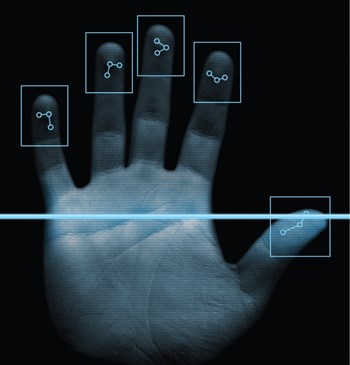
While it’s true that over the last two decades, New England has become a safer place to call home, that doesn’t mean that security concerns don’t still exist—especially for those in condos or HOAs. While security guards, electronic gates and doormen are a good start for providing residents with a welcome sense of security, thanks to recent technological advancements, there are now a multitude of other ways for condo-dwellers to protect themselves and their property.
Covering the Bases
“It’s easy to do a return on investment and compare the cost of physical security vs. electronic,” says Christopher J. Wetzel, executive vice president of an East Coast-based security firm, “and the latter has proven to be cheaper. If electronics are deployed properly and you’re using the right technology, there’s consistency you will get day in and day out that you might not get if you rely strictly on the human element.” That being said, Wetzel says he feels that some presence of both is really the ultimate safeguard—a physical presence of some kind backed up with video and technology systems.
Janett McMillan, director of sales and marketing for ADT Security, says the more exclusive the community is, the higher the expectation for a comprehensive security program.
“Managers of residential buildings and developments are looking to full-service providers like ADT Security to assess their security needs for residences, buildings, property and common areas and present options and recommendations,” she says. “Increased crime is a significant factor. The association must be proactive and have the proper layers of protection in place to prevent the community from becoming a target.”
Bells and Whistles or Necessary?
Robert Kravets, CMCA, PCAM, president of Realty Corp. of Boston, says waiting until there’s an incident, possibly a serious one, is not the way to start. Most properties don’t need major security beyond door locks, lights, etc., but there are exceptions. “We have one property that’s extremely security-conscious; they have all kinds of (electronic) stuff and have for 30 years. We’ve had security evaluations done by security people, alarm companies. They used to have incidents there all the time, and they haven’t had them for a really long time now. That’s partially because the makeup of the area around the property changed, and because we have a tight system there.”
These clients initially thought technology would replace the cost of live security personnel. “After seven years, it turned out it could not be done,” Kravets says. People depend upon security guards to be there, regardless. “They want another person around to run and check things out. You need someone to say ‘Help is on the way,’ or keep them warm from trauma. You can’t do that through surveillance.”
What’s Available?
According to McMillan, there are a number of options available, including residential and community-owned security systems, closed-circuit television (CCTV), access control, perimeter protection and panic alarms. More affordable options are available for cameras and video for monitoring gate entries, common areas and buildings.
“The demand for video continues to increase significantly,” says McMillan. “Cameras are used in both outdoor and indoor applications to assist in crime prevention, detection, identification and in limiting the association’s liability. Of course, life safety protection for fire and carbon monoxide is extremely important, especially in connected units, like townhomes and condos.”
Ralph C. Jensen, editor-in-chief of Security Products Magazine, says lower-income housing generally depends upon what each municipality’s Housing Authority will provide; generally fixed camera units. Higher-end housing may include 'virtual doorman' systems and 1080p wireless, networked cameras. “The idea that these are networked means they will transmit data back to a control facility where an operator can view circumstances and act accordingly,” he says. “Networked cameras are the new trend. Sending data to a control center where an operator can monitor.”
Jensen says he recommends cameras because they capture every detail, and aren't prone to the kinds of lapses humans eyes and memories can have. “The human element is fallible and makes mistakes,” he says. “A camera can see more area and more often. It captures any incident without fail and without missing important details. Cameras also come with nighttime capability and thermal viewing features.”
In the Cloud
Charlie Howell, a security consultant and principal of Division 28 Consulting, a national company that regularly deals with multifamily security across the U.S., says the hottest trend for both the vertical and communal-style communities is mobility.
“The physical security industry has embraced the consumers' habit of wanting things on their smartphones and tablets,” he says. “We have seen the latest trends combining cloud processing and storage with apps and browser-based programs that allow tenants/residents to access front gate or front door communication, video, and access control with their smartphone or tablet.”
According to the pros, ask anyone who lives in a condo what their biggest wants are for security and a majority of the time the answer will be A/V screens for interacting with visitors and deliveries and video surveillance of their vehicle that can be seen from their residence.
“For entry to the building the latest units are combining the video, door release, and intercom features into behind-the-scene engines that use cloud processing and storage for ease of maintenance and retrieval,” Howell says. “In fact, though these combined units feel like one item with one engine, they are separate components that separate the intercom, video, and door release. The intercom is becoming a network-based item but not necessarily in the cloud. The door release and video are absolutely cloud-based modules within the single unit frame.”
For a communal condo community, Howell says the biggest “want” is video surveillance on entry to the community that is then governed by the management or HOA.
“The trend in these systems is getting better quality video that is processed and stored in the cloud so less equipment to maintain and a better ease of accessing the video for searches,” he says.
In more upscale associations or condos, Wetzel sees more systems installed with high-resolution video cameras and analytic capabilities that are passed on to a security staff or security firm to better evaluate what’s going on in the building community.
“I’m seeing some video where it has facial recognition and has the ability to look at a person and know if they need to unlock a door, or see that there are two people in an area, and know that they should not unlock the door,” he says. “Most advancements are on the video side like this.”
Making a Choice
When looking into adding or upgrading a new security system, the manager, board members and onsite security should determine their objectives and discuss possible solutions with the representative of a reputable security services provider.
Jensen feels an HOA should get the opinion of a security expert or consultant when deciding on the best method to go with. “There is a non-profit organization of professional security consultants across the nation called the International Association of Professional Security Consultants (IAPSC). They go through countless measures to qualify and vet security consultants to make sure only the ones with integrity are listed in their consultant search,” he says.
Managers and boards must do their homework when it comes to find a full-service company with a proven history of meeting the needs of community associations. These can be identified through recommendations from other managers and directors of security, by considering business partners of organizations like the Community Associations Institute (CAI) where a vendor’s membership shows a commitment to serving community associations and an understanding of this service. Community association trade shows and expos like New England Condominium’s Condo Expo, also provide vendors for consideration. The next Expo will take place on Tuesday, May 24, 2016 at the Seaport World Trade Center in Boston, where you can meet up with security vendors and other service providers.
“It is extremely important to choose a licensed, full service provider who can assist with all of your needs. The company you select should employ a team of licensed, vetted technicians, customer care and technical support,” McMillan says. “Many companies subcontract their monitoring and service to a third party, or are dealers for other companies. It is important to confirm that the company you choose is actually the company that will be performing all of the services, so that they can be held accountable for their performance.”
A security company should also provide the association with a comprehensive proposal with a number of options and detailed explanation of each so there are no misunderstandings and expectations are met. “Camera type, location and video recording and retention must be considered,” McMillan says. “The proposal should include clearly defined prices, terms and a timeline that meets the customer’s needs.”
According to Wetzel, when purchasing security equipment, confirm in advance if the equipment is proprietary and understand what will be required to service the equipment in the future. In other words, “Make sure that the system programming is not locked so that another provider can assume the monitoring and service of the equipment,” he says. “If the system is proprietary or the programming is locked, you may not be able to change providers without incurring additional costs or replacing the equipment.”
Cost Concerns
The price of technology runs the gamut, and the higher-quality video you utilize, the more it will cost.
“The costs of these systems is totally dependent upon the number of openings or entries controlled, the amount of video or access control records stored, the amount of bandwidth infrastructure between the site and the Internet, and the quality of the video being pushed, stored, and retrieved,” Howell says. “The costs range from a low-end number per door for basic elements around the $2,000-$3,000 installed mark to more elaborate systems on more doors where the per door cost drops but the ongoing storage costs rise.”
Cloud storage can be priced easily online and is typically between free for a 2GB storage system up to $10 per 250GB. Some cloud storage solutions run from $50 to $100 but pricing depends on what you are using it for.
McMillan says an association receives a significant savings on security services with a bulk monitoring agreement for the entire community. “The monitoring rate is a fraction of retail and offers residents discounted pricing for equipment and services i.e., intrusion, fire, home video, interactive solutions and home automation, which are in great demand,” she says. “When security services are part of the community amenities, security is enhanced on a community-wide basis.”
Playing a Role
According to Howell, some of these video methods weren’t done in the past not due to cost, but because the life-cycle management required too much time from the agents, boards, and building staff. Now, both the property manager and building staff have been able to benefit from the systems beginning to use cloud-based processing and storage, as it has taken a great deal of responsibility away from them.
“The total cost of ownership is reduced by no longer having to maintain equipment because now the processing server and storage devices are in the “cloud” or simply maintained by somebody else as a service,” Howell says. “Another benefit of these new trends in technology is that when law enforcement or a homeowner wants to see the video they are able to send a link in an email to the video instead of having to burn it onto a DVD or thumb drive along with a proprietary reader.”
Whether you live in a more modest community or a deluxe development, security is something everyone thinks about. Making smart choices and taking advantage of the ways available technology can meet your particular needs while controlling cost is one way for boards and managers to fulfill their responsibility to residents.
Keith Loria is a freelance writer and a frequent contributor to New England Condominium.









Leave a Comment